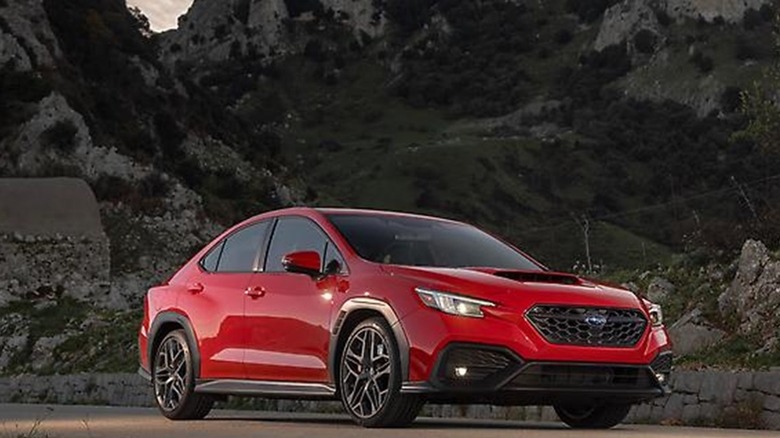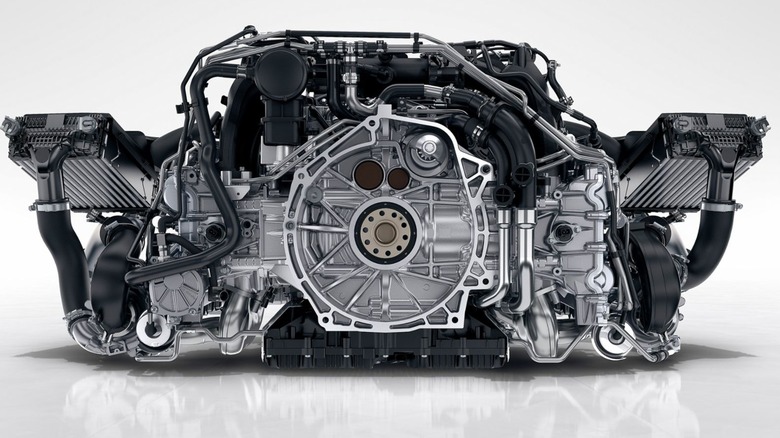Boxer Vs. Inline Engines: What's The Difference And Is One Better Than The Other?
Boxer and inline engine layouts are among the best power plants used in automobiles and motorcycles, each presenting pros and cons to consider. Boxer engines most often use four- or six-cylinder designs, where inline engines have ranged from eight-cylinders down to three. Oddly, inline engines can be found in every number of cylinders except seven, and most car companies don't build inline five-cylinders either.
It's also true that most car and motorcycle makers don't use boxer engines or inline engines with more than four cylinders. However, the inline six-cylinder is making a comeback.
The primary difference between boxer and inline engines is the orientation of the cylinders. A simple visual example involves setting four (or six) soda cans upright on a table, forming a line pointing away from you. This represents the cylinder arrangement of an inline engine.
Now, take the closest can and lay it on its left side, pivoting the can on its edge without it leaving the surface of the table. Next, lay the second can on its right side in the same manner. Finally, lay the remaining cans on their sides, alternating left and right. Viola, a rudimentary depiction of the boxer engine layout. You can see why it's also known as the horizontally opposed-cylinder engine. Let's explore the pros and cons of each engine type and see if one is better than the other.
The pros and cons associated with boxer and inline engine layouts
To start the discussion, we'll introduce Jason Fenske from the YouTube channel Engineering Explained and his comparison of 3D-printed model four-cylinder engines of each type. As both engine layouts rotate through a complete four-cycle operation, each pair of pistons cancels out the vibrations of the other. However, the inline four-cylinder creates secondary vibrations, occurring during the bottom half of the piston stroke, that require additional measures to control compared to the boxer layout.
While inherent engine balance is a pro in the four-cylinder boxer column, it has a tendency to rock front to back due to its offset cylinder-pair orientation. Interestingly, all vibration forces and rocking cancel out in six-cylinder boxer and inline engines.
The most significant advantage of the boxer engine design over the inline layout is its low profile. Sitting lower in the car's engine bay keeps the center of gravity lower to enhance cornering and braking characteristics. In some frontal collisions, the boxer's lower engine placement reduces the odds of the engine entering the passenger compartment.
Inline engines are narrower and taller than boxers, often making them more accessible. Their compact size is especially beneficial for any service involving spark plugs, valve train adjustments, or head gaskets.
When comparing dual-overhead-cam engines, inline varieties have half as many cylinder heads, camshafts, and timing chains. The reduction of components and resulting simplicity makes inline engines less expensive to produce, their most significant advantage over boxer engines.
Comparing boxer and inline engines, is one design better than the other?
Both engine designs present strengths and weaknesses. The boxer engine is more costly to produce and more difficult to service. Its width also affects an automaker's decisions concerning suspension geometry and steering angle. Of course, the rear- and mid-engine placement found in most Porsche cars and older VW Beetles eliminates the steering angle concern.
The inline engine design's compact size and lower cost are significant advantages that likely explain its dominant use by modern automakers other than Subaru, Porsche, and the occasional Toyota. However, less expensive and widely used doesn't always equate to better.
Unless you're designing a commuter car for the masses, the boxer engine's low center of gravity makes it better for sports cars like those found in a variety of cars from Porsche. However, "sports car" isn't exactly a defining term for Subaru's lineup.
Subaru's inclusion of its Symmetrical AWD as standard equipment on the vast majority of its vehicles is an indication of the company's commitment to its uniqueness. That commitment makes it easier to understand why Subaru continues to use the boxer engine despite equally reliable engine designs being available at lower cost.

